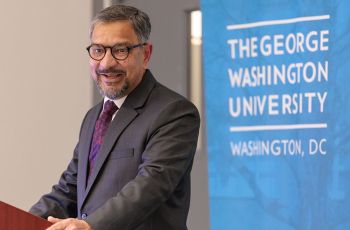
Prostate cancer is one of the most common cancers, making Prostate Cancer Awareness Month, recognized every September, a good reminder for men to stay on top of their health. In 2021 alone, the American Cancer Society estimates there will be close to 250,000 new cases of prostate cancer diagnosed. Michael Whalen, MD, however, says that when caught early, this cancer is largely curable.
Here, Whalen, associate professor of medicine, chief of urologic oncology, director of the Genitourinary Multi-Disciplinary Clinic, and site director of the National Cancer Institute Fellowship in Urologic Oncology at the George Washington University (GW) Medical Faculty Associates (MFA), discusses, risks, warning signs, and prognoses.
Q. Who is at greatest risk of developing prostate cancer?
Whalen: All men are at risk for developing prostate cancer. The disease affects about one in seven men. Therefore, every man should discuss the benefits of prostate cancer screening with his primary care doctor.
Prostate cancer can be hereditary as well. There are some families that have higher rates of prostate cancer compared to the general population. Therefore, any man with a first-degree relative (i.e. father, brother) or second-degree relative (i.e. uncle) may be at higher risk.
Also, race is a factor for prostate cancer risk, with Black men being at higher risk for developing the disease compared to white and Asian men. Interestingly, while men born and raised in Asia have a lower incidence of prostate cancer, if they move to the U.S. and adopt the typical “Western diet" of meat, foods high in saturated fat, and processed foods, their risk for prostate cancer increases.
Q. What are the signs of prostate cancer?
Whalen: Since our country has adopted a widespread screening program for prostate cancer, such as PSA, or prostate-specific antigen, blood testing, the disease is usually detected at a very early stage. Therefore, there are usually no physical signs or symptoms of the disease. Men usually feel completely normal and may actually be very healthy.
Some men will have a nodule or abnormal finding on a rectal examination. Although some men will have difficulty with urination - weak stream, urinary frequency or urgency, or urinating multiple times at night - these symptoms are typically from prostate enlargement rather than cancer.
About 5% of men are diagnosed with prostate cancer that has already spread or become metastatic. This scenario may be accompanied by fatigue, weight loss, bone pain, or even blood in the urine. So, while most people with prostate cancer have no symptoms, any of these symptoms should prompt a thorough discussion with a health care professional.
Q. How is prostate cancer diagnosed?
Whalen: All men over the age of 55 should have their PSA blood test checked by their primary care provider. For men with elevated risk of developing prostate cancer (men with family history or Black men), the age of the first PSA test should be between 40 and 45. When the PSA blood test is elevated above 4ng/mL (or above 2.5ng/mL for men in their 50s), this triggers a pathway for further testing by a person’s primary care provider. Typically, the person will be referred to a urologist for further testing.
The PSA is a good screening test, but PSA elevation does not always mean prostate cancer. Benign prostate hyperplasia, urinary or prostate infection, regular bicycle riding, and even recent sexual activity can cause the PSA to be high. Fortunately, these days, there are other blood- and urine-based tests that may be used to more specifically determine a man’s risk for harboring prostate cancer. At GW we have access to many of these tests to give us the most accurate assessment of a man’s risk.
Some of these tests include the 4K score and Prostate Health Index blood tests, as well as the ExoDX urine test. We often use prostate MRI testing, or a scan of a man’s pelvis and prostate, to be able to directly visualize the prostate to look for tumors. Based on the rest of these tests and imaging, if the suspicion for cancer is still high, then we will recommend a prostate biopsy to sample tissue.
GW uses sophisticated MRI-ultrasound fusion technology to enhance the diagnostic accuracy of the prostate biopsy, or fusion biopsy. The biopsy is performed in the urology clinic as an outpatient procedure under local anesthesia. We have worked hard at GW to develop biopsy protocols to minimize discomfort and infection risk while providing high diagnostic accuracy, including the incorporation of the transperineal approach for select patients. Therefore, a prostate biopsy is needed to diagnose prostate cancer.
Q. How do you treat prostate cancer?
Whalen: There are many treatment options for prostate cancer, and the landscape is still evolving. Some non-aggressive prostate cancers may not need to be treated right away but may be watched for many years with a program of active surveillance.
Prostate cancers that are more aggressive at diagnosis often benefit from treatment. These treatments include surgery to remove the prostate, or radical prostatectomy, as well as radiation therapy and hormone therapy, such as androgen deprivation therapy. These therapies may be used alone or in combination.
There is also growing interest in more experimental therapies such as focal-ablation, which involves treating the tumor alone while leaving the rest of the prostate intact. Recent advances in MRI technology have made focal-ablation a possibility, but not every man will qualify for such experimental treatment, which is often done in the context of a clinical trial.
The treatment pathway depends on many factors, such as patient age, other medical problems, and stage and grade of disease, meaning the extent and aggressiveness. We work very hard at GW to develop personalized treatment plans for each patient that incorporate not only these factors, but also the patient’s preferences, expectations, and values. Our cancer surgeons have performed more than 2,000 operations. Our radiation specialists use the latest technology and treatment protocols. The majority of patients with prostate cancer not only can be treated, most are also cured of their disease.
Q. What are the survival rates for prostate cancer?
Whalen: Given the widespread screening program in the U.S., prostate cancer is often diagnosed early and is therefore very curable. The 15-year survival rates are often greater than 90%. Only about 3% of men diagnosed with prostate cancer will succumb to their disease. This is why it is so important for men to discuss prostate cancer and PSA screening with their primary care providers.
Early detection has the greatest chance of cure. For men who have metastatic disease at diagnosis, the prognosis has also improved vastly over the last five years. Findings from large clinical trials have provided us with new, more effective medications and strategies to battle the disease and extend years of life.
Q. How does GW care for patients with prostate cancer?
Whalen: At GW, we prioritize personalized and precision medicine for men diagnosed with prostate cancer. We spend much time discussing the cancer profile and making sure that the patient and his family understand his options for treatment.
GW has a Multidisciplinary Genitourinary Cancer Clinic, where a patient spends the afternoon in discussion with cancer doctors from multiple different specialties: urology, medical oncology, and radiation oncology. Patients and their families have ample opportunity to ask questions to understand their diagnosis and their treatment options.
Also, GW has access to many national clinical trials that allow us to bring cutting-edge medicines and treatment protocols to patients in the Washington, D.C., metro region. We also conduct clinical outcomes research on prostate cancer and prostate MRI using a large patient database. Findings from this research program have been presented across the country at regional and national conferences.
The GW prostate cancer program also strives to incorporate the latest technology into our treatment strategies. Some new tools include the use of the da Vinci Xi robot for radical prostatectomy, the latest generation of MRI-ultrasound fusion biopsy equipment, transperineal prostate biopsy, and hydrogel spacer prior to radiation therapy.
We understand that effective cancer treatment not only involves treatment of the physical condition, but also the mental, emotional, and spiritual. The GW Cancer Center holds regular support group meetings for men with prostate cancer who are at various stages of their treatment journey.
Q. Anything you’d like to add?
Whalen: Our prostate cancer team understands that being diagnosed with prostate cancer brings a great deal of anxiety and uncertainty for patients and their families. We work hard to equip patients with the information they need to feel comfortable about making the best decisions about their plan of care. Our goal is to provide guidance, reassurance, and cutting-edge precision medicine as we work toward a cure.
For more information about our program and providers, visit GW MFA Urology and Urologic Services. To make an appointment, call (202) 741-3100 or email uroappointment [at] mfa [dot] gwu [dot] edu (uroappointment[at]mfa[dot]gwu[dot]edu). For more information on support group meetings, contact Sara Field at sfield [at] mfa [dot] gwu [dot] edu (sfield[at]mfa[dot]gwu[dot]edu).



